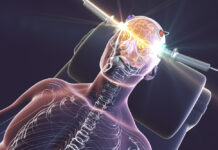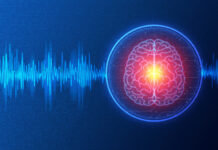This week on MIA Radio we turn our attention to Electroshock or Electroconvulsive Therapy (ECT) as it’s known in the UK. On Wednesday, September 19th, this emotive and controversial intervention was discussed at the 57th Maudsley debate, held at Kings College, London.
The motion proposed was: “This house believes that ECT has no place in modern medicine”.
Supporting the motion were Professor John Read who has undertaken several scientific reviews of the literature supporting the use of ECT and Doctor Sue Cunliffe. Doctor Cunliffe was a paediatrician until she herself underwent ECT, after which she became cognitively impaired and found herself unable to continue working in medicine. She now campaigns for the risks of ECT to be made more explicit and to directly address the professional denial of the damage that ECT can cause. Speaking against the motion were Professor Declan McLoughlin and Dr Sameer Jauhar.
Both John and Sue took time out to talk about the debate and the wider issues surrounding ECT.
Professor Read and Doctor Cunliffe kindly shared their debate notes, which are provided below. To watch the debate on YouTube, click here.
John Read
Thank you to the Institute for bringing us all together.
Let us first remind ourselves that history is littered with procedures which people believed in– just as strongly as some psychiatrists believe, today, in electrocuting people’s brains to cause seizures – but which turned out to be ineffective or damaging. The list includes spinning chairs, surprise baths, standing people next to cannons, and, more recently, lobotomies.
It was 80 years ago, in 1938, that Ugo Cerletti administered the first ECT, to a homeless man in Rome. After the first shock the man called out ‘Not another – it will kill me’.
The theory back then was that people with epilepsy didn’t have schizophrenia so the cure for schizophrenia was to cause epilepsy. So Cerletti was driven by the genuine belief that causing convulsions by shocking the brain really might help people, by the genuine hope that we might finally have come up with an effective treatment.
The story of ECT illustrates, yet again, however, what happens when our beliefs and good intentions are not tempered with good science.
ECT quickly spread from Rome across Europe and America. Finally, an effective treatment! People who received it were discharged earlier….… by the doctors who gave it. But there were no studies for 13 years, by which time everyone just knew it worked, and their belief may have been very helpful to some patients. The first study on depression (which became the main target for ECT), in 1951, found that those who had ECT fared worse than those who had not had it. It made no difference.
I have co-authored four reviews of the ECT research, most recently last year. There are only ten depression studies comparing ECT and placebo; placebo meaning the general anaesthetic is given but the electric shock is withheld. Five of those 10 found no difference between the two groups. The other five found, compared to placebo, a temporary lift in mood during the treatment period, among about a third of the patients. One of these five found that this temporary improvement was perceived only by the psychiatrists, but not by the nurses or the patients.
Most reviews and meta-analyses assert, on the basis of these temporary gains in a minority of patients, that ‘ECT IS EFFECTIVE’
But none of them have ever identified a single study that found any difference between ECT and placebo after the end of the treatment period. There is just no evidence to support the belief that ECT has lasting benefits, after 80 years of looking for it.
Similarly, there are no placebo studies to support another genuinely held belief: that ECT prevents suicide.
There is nothing wrong with treatments working because of hopes and expectations. But passing 150 volts through brain cells designed for a tiny fraction of one volt causes brain damage. Indeed, autopsies quickly led to a new theory about how ECT works. In a 1941 article entitled ‘Brain damaging therapeutics’, the man who introduced ECT to the USA, wrote ‘Maybe mentally ill patients can think more clearly with less brain in actual operation’.
In 1974 the head of Neuropsychology at Stanford wrote: ‘I’d rather have a small lobotomy than a series of ECT….I know what the brain looks like after a series of shock’.
All ECT recipients experience some difficulties laying down new memories and in recalling past events. What is disputed is how many have long-lasting or permanent memory dysfunction, which might reasonably be called brain damage.
Findings range from one in eight to just over half. A review of studies that actually asked the patients, conducted here at the Institute, found ‘persistent or permanent memory loss’ in 29 to 55%.
Yet another belief is that ECT used to cause brain damage, in the bad old days, but not any more. But a recent study found one in eight with ‘marked and persistent’ memory loss, ….. and also found much higher rates among the two groups who receive it most often, women and older people.
The same study also found that the memory loss was not related to severity of depression. This is important because another belief about ECT is that the memory loss is caused by the depression, not the electricity.
Psychiatric bodies in the UK and USA recite the belief that only ‘one in 10,000’ will die from having ECT, without producing a single study to support that belief. Our reviews document large-scale studies with mortality rates between one in 1400 and one in 700, several times higher than the official claims, typically – unsurprisingly – involving cardiovascular failure.
ECT in England has declined, from 50,000 a year in the 1970s to about 2,500. The number of psychiatrists who still believe, despite all the evidence, is dwindling fast.
It may have been understandable for the psychiatrists of the 1940s to believe that ECT worked and was safe. They didn’t know any better.
But if psychiatry wants to be an evidence-based discipline, to be part of modern medicine, it must acknowledge that, despite all its honourable intentions, it has got this one, like lobotomies, woefully wrong.
Thank you.
Sue Cunliffe
14 years ago, 21 electric shocks were passed through my brain. I can’t use the word therapy because it caused life changing brain damage.
Tonight, you decide- An inherently dangerous treatment or institutionalised negligence and cover up?
Memory loss is brain damage.
Brain damage causes a reduction in a person’s ability to function. Its full impact can only be assessed by looking at how it changes lives. I used to be a doctor, I can no longer practice. I have lost much of my independence.
I have got expert at managing my brain injury. How to mask my disability and maximise my functioning. Believe it or not there are days when my brain fails me and I struggle to hold a conversation or cook a meal.
The most traumatising aspect is the ongoing denial that I, and thousands of other ECT victims have suffered brain damage. We are denied the support that we desperately need to help us adapt to living with our brain injury. Our risk factors for depression and hence suicide are increased, as we now have a lifelong disability; many suffer job loss, financial ruin and some lose homes and families.
In its 2017 patient leaflet the Scottish ECT Accreditation Network states that ECT does not cause brain damage and warns patients to be wary of the misinformation on the web about the negative effects of ETC.
I am not misinformation. I am the truth.
Was my brain damage too subtle for medical staff to diagnose it?
My hands shook, I had poor balance and coordination. I fell over in public. I walked into door frames, my memory was so bad I didn’t know if that was normal. My speech was slurred I had word retrieval problems and I couldn’t read. I lost the ability to do simple maths; including how to use money. I could not recognise family and friends. Still today I am unable to drive when or where I like and navigating is a nightmare. My long and short-term memory was completely destroyed.
Emotions are stored as memories. I could experience love and happiness but I couldn’t remember how that felt when the moment was past.
Contrary to ECT literature brain damage does affect how new information is processed; so trying to relearn things has been a long and arduous task.
My children have suffered, my daughter often had to assume the role of child carer.
I am a lucky ECT victim. I survived 2 years of brain damage denial, and psychiatric hell; then a neuropsychologist diagnosed me with brain damage caused by ECT. His talking therapy cured my depression. It took 3 years of specialist support to learn to live with traumatic brain injury. I am permanently traumatised. I have never received an apology; without which I can never heal.
Many may argue that ECT is safer now than when I had it.
Many may try and dismiss John’s statistics of up to 55% suffering brain damage.
What they cannot dispute is their own data. Data published by the Royal College of Psychiatrists ECT accreditation service. Results taken from their own 2014 patient survey. This study identifies that 63% of their respondents suffered memory loss to some degree. And 18% suffered severe/permanent memory loss. This is more than likely an underestimate; but it means that a minimum of 1 in 5 ECT patients were left with severe permanent brain damage. The same survey identified that to reduce the suicidal thoughts in 1 person 12 people suffered severe permanent brain damage.
The NHS have produced a risk assessment tool that standardises risk. Even if we put the lowest figure of 18% of patients suffering severe permanent brain damage into this risk assessment tool ECT is classed as posing an extreme risk to patients, which means that management must be informed of the incident and urgent action taken.
Yet, The Royal College ECT information leaflet states that ETC is safe and in their 2017 ECT statement claims that side effects are occasional.
It is sickening and dehumanising to have my life devalued by psychiatrists. They appear so detached from reality; 1 in 5 patients suffering life changing brain damage appears to be totally inconsequential. They demonstrate no remorse or concern.
If psychiatrists failed to recognise and report my devastating brain damage how many others have been missed and not reported? I believe that if every incident had been reported ECT would not be in use today.
Should we also be concerned that it is these same doctors that are producing research to say that ECT is safe?
The same institution that releases comprehensive annual ECT data yet fails to mention rates of brain damage?
I do not doubt there are people who feel better following ECT, some may judge any memory loss that they may have suffered to be worth it. However, good quality talking therapy is safe and can achieve the same result; so why bother using ECT?
If you were asked to assess a new treatment for the NHS, which after 80 years of trials, had no conclusive evidence to support long term benefit, yet it was associated with a risk of a 1 in 5 patient suffering severe brain damage, would you introduce it today?
Thank you for allowing me to speak today. My story has been repeated thousands of times over throughout history and the world, and still goes on today. Show compassion for these silenced and scared victims. Let them know that their voices have been heard tonight and vote for the motion.
Links and Further Information
To read a report on the first ever Maudsley Debate, held in January 2000, which also discussed ECT, click here.
ECT Accreditation Service (ECTAS)
The effectiveness of electroconvulsive therapy: A literature review, John Read and Richard Bentall















PLEASE be HONEST!
“ECT” = Electro-Cution Torture!
Report comment
About 15 years ago, when she was 22, my friend’s Mother forced her to undergo ECT. My friend has not been the same since. She has poor memory and learning skills, and is only able to barely maintain some limited independence in subsidized housing, a small disability pension, and Food Stamps. She’s a wonderful person, and a good friend, but she is also STILL a VICTIM of psychiatry and the local “Community Mental health Center”. She is forced to take neuro-toxic drugs which she doesn’t want, doesn’t need, and which are harming her. If ECT did her ANY good, I certainly can’t see it. All I can see is an increasingly VICTIMIZED VICTIM. ECT is nothing more than the tip of the iceberg of psychiatry’s GENOCIDE. ECT belongs on the scrap heap of history.
ECT = Electro-Cution Torture
Report comment
THE WONDERFUL AND HORRIBLE PARADOX OF THE HUMAN CONDITION?
John Read speaking about the placebo affect of expectation that ECT would cure or heal a brain problem describes the tempory lift in mood that people experienced as “a wonderful and horrible paradox.”
And here’s the thing. The lift in mood and behavioral capacity to function normally for a while appears to both the person who received the ‘treatment” and those who observe a return to normal function is based on the paradox of human motivation and perception. The existential paradox being that none of us can give a first-person account of ‘how’ we do being human. None of us can say how the two quintessential human behaviors of walking and talking are orchestrated by internal processes that cannot cross the threshold of conscious awareness, because our nervous system functions at millisecond speeds that defies any mechanistic, cause and effect explanation.
But we can, by studying the mounting evidence concerning the structure and function of our nervous system, learn a better form of self-regulation through a sensation awareness and acceptance of the muscular tensions and vascular pressures that underpin our human motivation and perceptions. We can, in fact, become aware of brain motions and understand how ECT treatment might provide its short-term relief of re-traumatizing memories. Please consider this questioning of inner motions and the possibility that our famous intellect is a self-defense against feeling our body’s powerful and disorienting sensations:
“We would object less to the irresponsible brain operations and lobotomies which are performed to kill the devil in the organism if they served to disclose the dynamic functions of the brain. Such questions as “Does the brain move? Does it contract and expand when working, just as other organs such as the heart, intestine, glands, etc., do?” are of the utmost importance for medical pathology and the understanding of the organismic functions. It would be highly important to invent a device which would enable the brain specialist to observe the brain in its natural state.
THE INTELLECT AS DEFENCE FUNCTION
It is commonly assumed that the human intellect has a solely objective function and that it is directed toward the world; ethics and philosophy in particular conceive of reason and intellect exclusively in the sense of an absolute non-emotional activity capable of comprehending reality “incorruptibly.” Two things are overlooked here: (1) the intellectual function itself is a vegetative activity; and (2) the intellectual function may have an affect charge whose intensity is no less than any purely affective impulse. Over and above this, character-analytic work reveals another function of the intellect which ties in very well with the inversion and opposition of drives discussed earlier. Intellectual activity can be structured and directed in such a way that it looks like a most cunningly operating apparatus whose purpose is precisely to avoid cognition, i.e., it looks like an activity directing one away from reality. In short, the intellect can operate in the two fundamental directions of the psychic apparatus: toward the world and away from the world. It can function correctly in unison with the most lively affect and it can also take a critical stand toward the affect. There is no mechanical, absolutely antithetical relationship between intellect and affect but, rather, a functional one.” Reich, Wilhelm, Chatacter Analysis (pp. 305-306)
I suggest, with all due respect of course, that if the 67th Maudsley Debate concerns the same motion, we will hear the same arguments from my Lord’s and my Lady’s Academia, who while presenting good word formulations about what they did and do to make a living, will not be able to acknowledge that they are as clueless as to how their thoughts are energized as the rest of us.
Report comment
We need to move beyond a debate (sorry I didn’t listen.. same old same old ?) on this to making the abusers accountable. It starts with a drug, when that screws people up…translation to their language: ‘treatment resistaint’ or it’s uncovered a ‘hidden psychosis’ (they are actually toxic on the drug) then it’s more drugs and usually a snow ball of polypharmacy in short order that will end up further down the line with a victim laying down with electrodes on their head. Ofcourse that ultimately fails and it’s back to the ‘mental illness’ if you get well enough to complaint…you lack insight…it’s the ‘mental illness’. NO IT’S CRIMINAL HUMAN RIGHTS ABUSE AND THE FIGURES SHOW…. MOSTLY AGAINST WOMEN.
Report comment
Thanks. An important subject.
Report comment